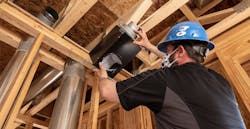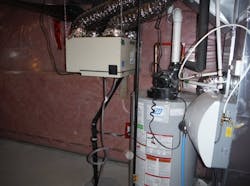How to Achieve Affordable Balanced Ventilation
Mechanical ventilation used to be a range hood that removed cooking odors and bath fans that cleared the air after a shower. Air exhausted by those fans was easily replaced by air infiltrating the house through gaps in the building envelope—essentially creating a self-balancing (if unregulated) air exchange system.
No more. Current energy codes and building practices seal those incidental gaps in the envelope. With that, the number and power of exhaust fans has increased; it’s not uncommon for a new home to have a continuous-run exhaust fan, a large-capacity clothes dryer, two or three bath fans, and a large range hood—all exhausting “dirty” and moist air to the outside.
Under those circumstances, today’s new-home construction practices require a mechanically balanced and controlled fresh-air ventilation system to protect the home and the health of the people who live there.
RELATED
- The Ultimate Z.E.N. Home's Indoor Air Quality System
- For Better Indoor Air Quality: Build Tight and Ventilate Right
Where’s the Makeup Air?
Without a mechanical fresh-air supply, negative pressures created by exhaust fans and appliances will draw makeup air through the relatively few, and small, gaps that remain in the building envelope. Think electrical outlets (which also draw particulates of insulation from stud bays as well as the attic) and walls that separate the home from an attached garage (which can introduce car exhaust as well as fumes from stored chemicals to the home). Yes, you can and should air seal the walls between the home and garage but it’s a tough detail to execute well.
And, due to a lack of makeup air and resulting depressurization, the exhaust fans can’t achieve their rated airflows, which will lead to indoor air quality problems inside the home.
The ROI of Balanced Ventilation
Despite these very real and potentially hazardous problems, most of the production builders I review still use exhaust-only ventilation.
Why? Cost. A focus on first costs blinds them to the return on investment of a balanced system, which results in fewer indoor air quality problems and customer callbacks.
Those leaks are enough to pollute the home’s air, but they won’t provide sufficient makeup air for the home’s exhaust fans.
But when you mention mechanically balanced ventilation to builders, their minds immediately go to the most expensive option: a heat- or energy-recovery ventilator (HRV or ERV), standalone units that transfer heat from exhaust air to pre-condition incoming fresh makeup air, and, in the case of an ERV, help keep humidity levels in check (see photo, below).
While these systems are effective, they are also expensive and difficult to install and maintain properly; as such, we usually only see them only where they are required by code or installed as a premium option selected by the buyer.
A Cost-Conscious Alternative for Mechanically Balanced Ventilation
A far more affordable solution, which is also more reliable and easier to install and maintain, is a ventilation supply fan that introduces fresh air to an HVAC return duct or, in homes without forced-air heating or cooling, from a mechanical closet or other out-of-the-way location (see main image at start of article).
The fan can be programed with a timer to run according to the home’s ventilation needs instead of continuously, saving energy. A sensor that shuts off the fan when the incoming air gets too hot, cold, or humid also is an energy saver.
Supply fans come in a range of capacities, the most basic and affordable of which provide 150 CFM or 160 CFM. More expensive models come with more power and perhaps a filter, which further freshens the incoming supply air.
A 160 CFM supply air fan won’t be enough power to balance short-term depressurizations, such as when the clothes dryer and range hood are running at the same time, but overall will supply enough makeup air to balance the system and maintain a healthy fresh air exchange—so long as it’s installed and timed correctly. Fortunately, unlike an HRV/ERV, this technology is very familiar to most HVAC installers.
Tim Kampert drives quality and performance in home building as a building performance specialist on the PERFORM Builder Solutions team at IBACOS.

